California’s diverse climate and landscapes create the perfect home for many types of oak trees, each with its own unique beauty and characteristics. Over my years of gardening and working closely with native plants, I’ve come to appreciate how these oaks not only enhance the landscape but also support local wildlife and ecosystems. Understanding the different types of oak trees in California can help gardeners and nature lovers make informed choices for planting and conservation.
From the towering Valley Oak to the hardy Scrub Oak, California’s oaks vary widely in size, leaf shape, and habitat preferences. Knowing how to identify these species is key for anyone interested in cultivating healthy oak trees or simply appreciating their role in our environment. Each type has its own story and value, whether it’s the evergreen Coast Live Oak shading a backyard or the rare Island Oak found only on the Channel Islands.
This guide introduces 12 common and fascinating oak species native to California, complete with pictures and identification tips. For experienced gardeners and newcomers alike, learning about these oaks will deepen your connection to the natural world and help you nurture these magnificent trees in your own garden or local green spaces.
Different Types of Oak Trees in California
Valley Oak (Quercus lobata)
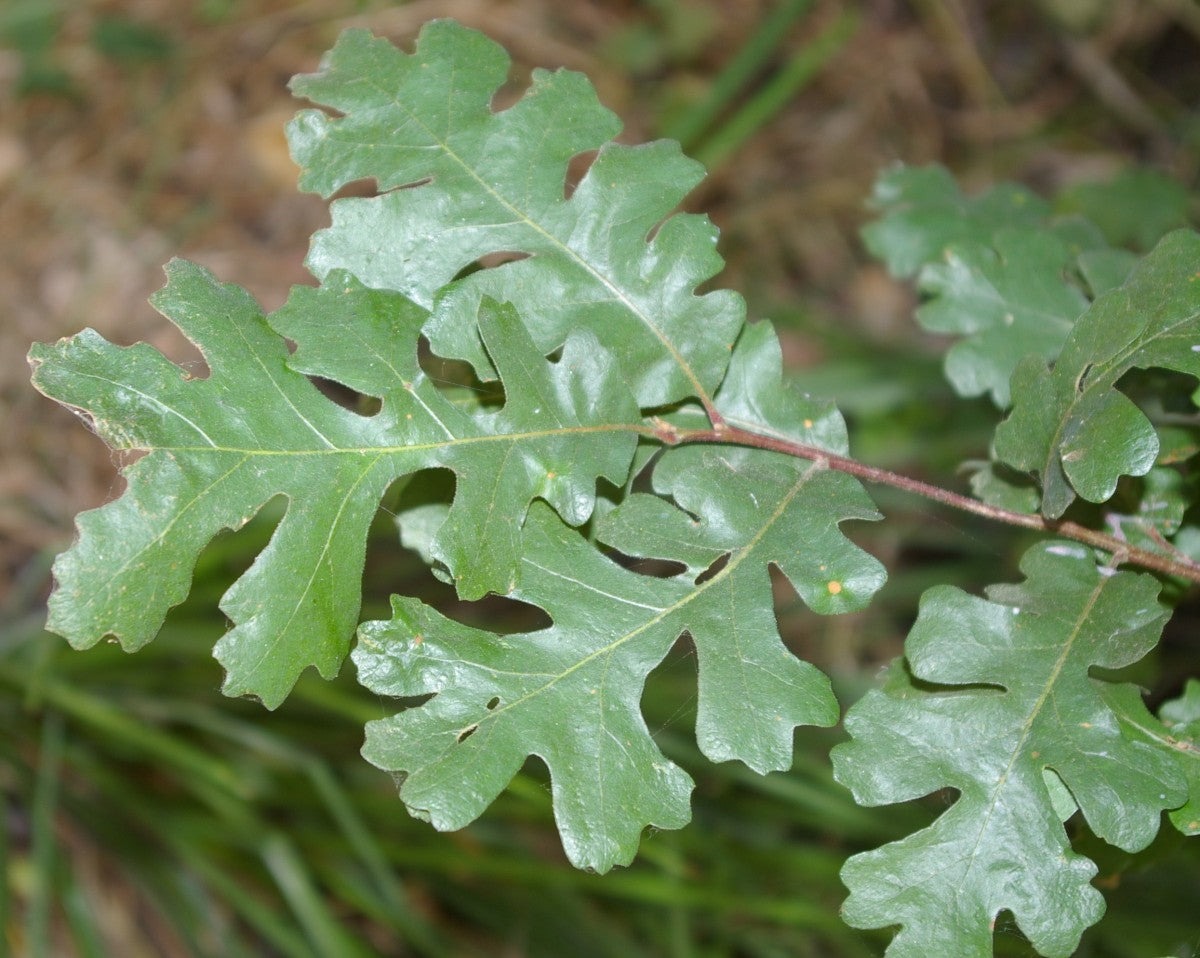
Valley Oak is one of the largest and most majestic oak species native to California. It is known for its wide-spreading crown and massive trunk, which can reach heights of up to 100 feet and diameters over 10 feet in ideal conditions. The bark is deeply furrowed and dark gray to brown, while its large, lobed leaves are bright green and turn golden yellow in the fall. Its acorns are relatively large and serve as an important food source for wildlife.
This species is easily identified by its distinctive leaf shape—broad with deep rounded lobes and a slightly wavy margin—and its enormous size compared to other oaks. Valley Oaks often grow as solitary trees or in small groves, creating expansive shade. The thick canopy and broad branches make it a striking presence in any landscape, especially when mature.
Valley Oaks prefer deep, fertile alluvial soils typically found in valleys and floodplains. They thrive in regions with hot, dry summers and cool, wet winters. This oak species requires access to groundwater or deep soil moisture, which supports its large size. It is less tolerant of drought than some other oaks but well adapted to California’s Mediterranean climate.
In California, Valley Oaks are commonly found in the Central Valley and lower foothills, stretching from northern to southern parts of the state. They are a keystone species in oak savanna and riparian ecosystems, supporting diverse plant and animal communities. Conservation efforts focus on protecting these oaks, which are vulnerable to habitat loss and water table depletion.
Coast Live Oak (Quercus agrifolia)
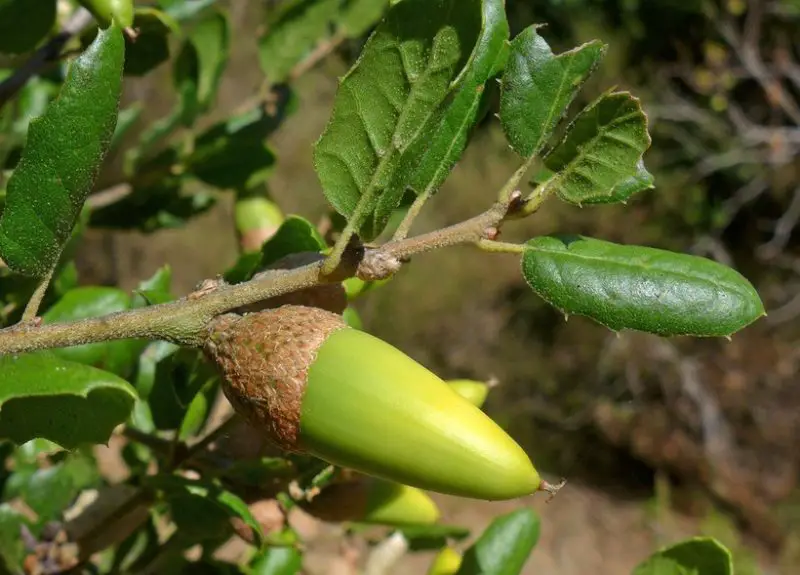
Coast Live Oak is a prominent evergreen oak native to California’s coastal and foothill regions. This species typically grows between 20 to 70 feet tall and forms dense, rounded canopies. The bark is dark gray to nearly black, deeply furrowed with age. Its leathery, dark green leaves are oval to oblong with smooth or slightly toothed margins and often have a glossy appearance, remaining green year-round.
The Coast Live Oak’s leaves and overall shape make it relatively easy to recognize. Its dense canopy provides shelter for many birds and mammals, and its acorns are a vital food source for local wildlife. Unlike deciduous oaks, Coast Live Oaks retain their leaves throughout the year, contributing to their role in stabilizing soils and providing consistent habitat.
This oak thrives in coastal environments, often found on rocky slopes, ridges, and valleys with well-drained soils. It is highly drought-tolerant and adapted to California’s Mediterranean climate with wet winters and dry summers. Coast Live Oaks also show resilience to salt spray and wind, making them common near the ocean and in chaparral communities.
Coast Live Oak ranges from the Oregon border south through much of California’s coast and into Baja California. It dominates many oak woodlands along the coast and nearby inland areas. This species is essential in urban and suburban landscaping due to its hardiness, drought tolerance, and ecological importance in supporting pollinators and wildlife.
Blue Oak (Quercus douglasii)
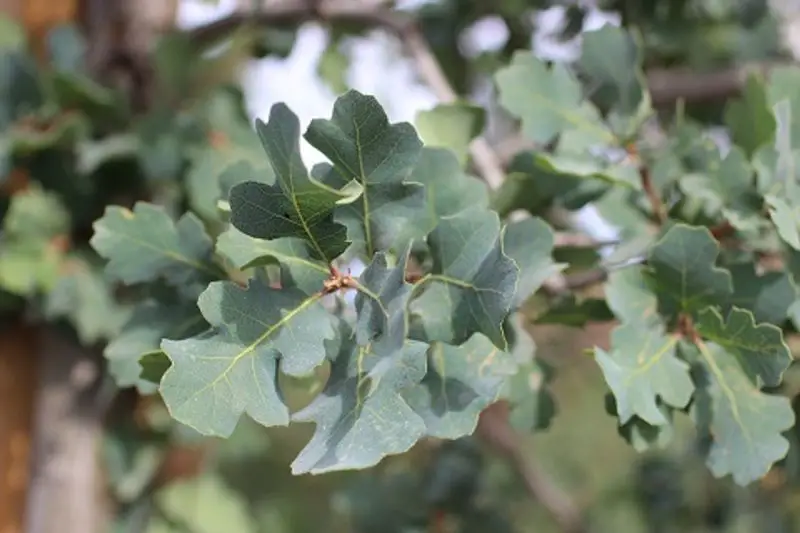
Blue Oak is a medium-sized deciduous oak native to the interior foothills and valleys of California. It typically grows between 30 and 70 feet tall with a rounded, open crown. The bark is light gray and develops shallow furrows as the tree ages. One of its most distinctive features is the bluish-green color of its leaves, which are thick, leathery, and often have a waxy coating that gives them a dusty, pale blue appearance.
The leaves of the Blue Oak are lobed but less deeply than many other oaks, with a smooth to slightly wavy edge. Its acorns are small to medium-sized, maturing in one season and serving as a food source for various animals. This oak often appears with a somewhat irregular, gnarled form that adds character to its appearance in natural landscapes.
Blue Oaks are well adapted to dry, rocky soils and areas with limited water availability. They prefer well-drained sites in foothills and lower mountain slopes and are highly drought-tolerant, capable of surviving in the hot, dry summers typical of interior California. This oak often coexists with grasslands and chaparral vegetation.
In California, Blue Oaks are primarily distributed across the Central Valley foothills, Sierra Nevada foothills, and parts of the Coast Ranges. They are an important species in oak woodlands and savannas, providing habitat and food for a variety of wildlife. Their resilience to drought and poor soils makes them a key player in California’s dryland ecosystems.
Canyon Live Oak (Quercus chrysolepis)
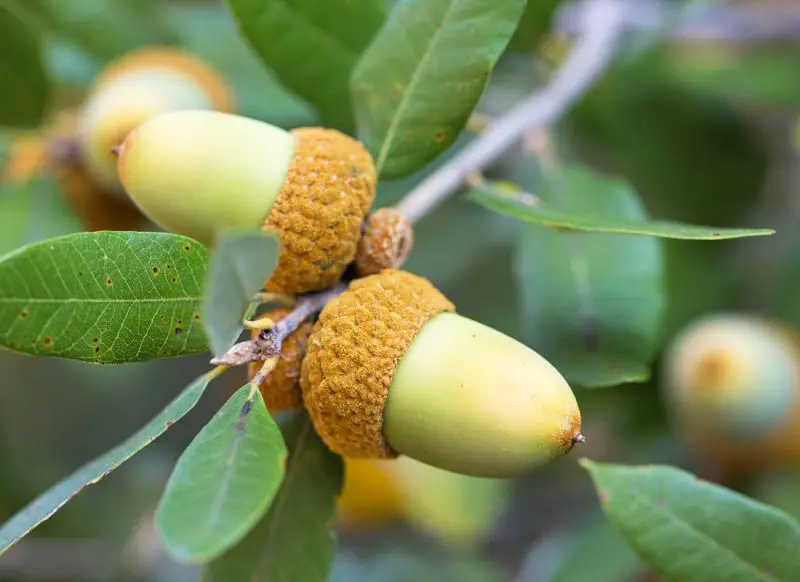
Canyon Live Oak is an evergreen oak species native to the mountainous regions of California. It generally grows 20 to 40 feet tall but can occasionally reach up to 70 feet under ideal conditions. Its bark is thick, rough, and deeply furrowed, with a grayish-brown color. The leaves are leathery, dark green on top, and lighter underneath, with sharply toothed or spiny edges and a glossy surface.
The leaf shape and texture help distinguish Canyon Live Oak from other oaks; its leaves are typically narrower with pointed tips and irregular, spiny teeth. This oak has a compact, often rounded crown and produces small acorns with a distinctive hairy cupule. Its evergreen nature provides year-round cover and food for birds, mammals, and insects.
Canyon Live Oak thrives in rocky, well-drained soils on steep slopes and canyons, commonly found in chaparral and mixed evergreen forests. It is highly drought-resistant and adapted to withstand wildfires, often resprouting vigorously after fire events. This oak prefers elevations from 1,000 to 6,000 feet and is well suited to California’s diverse mountainous terrain.
This species is widespread throughout California’s Coast Ranges, Sierra Nevada foothills, and southern mountains. It often grows alongside other oaks, pines, and manzanita shrubs. Canyon Live Oak plays a vital ecological role in stabilizing soil, supporting wildlife, and providing forage and shelter in its rugged habitats.
Black Oak (Quercus kelloggii)

Black Oak is a large deciduous oak native to California’s mountainous regions. It typically reaches heights of 40 to 80 feet with a broad, spreading crown and thick, dark bark that becomes deeply furrowed with age. The leaves are deeply lobed with pointed tips and have a glossy dark green upper surface and a lighter, sometimes fuzzy underside. In autumn, the foliage turns brilliant shades of yellow, orange, and red, adding striking color to forests.
Black Oak’s distinctive leaf shape with sharp lobes and the brilliant fall coloration make it easy to identify during the growing season. The acorns are medium-sized, maturing in two seasons and are an important food source for wildlife including deer, squirrels, and birds. The wood is dense and durable, historically valued for timber.
This oak prefers well-drained soils on mountain slopes and foothills, typically found between 1,000 and 7,000 feet elevation. It grows best in areas with moderate moisture and cooler temperatures compared to lower-elevation oaks. Black Oak is often found in mixed conifer and hardwood forests alongside species like Ponderosa Pine and Douglas Fir.
Black Oak is widely distributed across the Sierra Nevada, Cascade Range, and parts of the Coast Ranges in northern and central California. It contributes to forest diversity and provides critical habitat and food sources for numerous species. Due to its ecological importance, it is a focus of conservation in managed forests and natural parks.
Interior Live Oak (Quercus wislizeni)
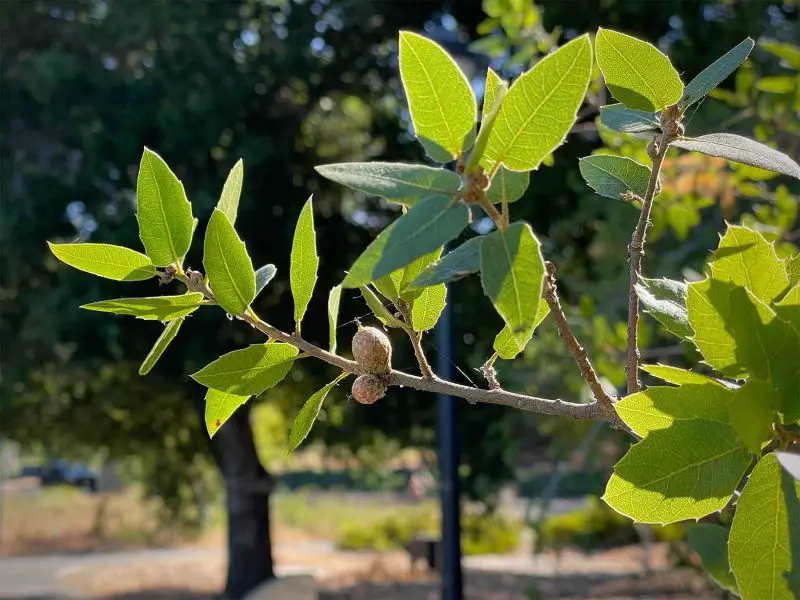
Interior Live Oak is a medium-sized evergreen oak native to California’s interior foothills and mountains. It usually grows between 15 and 40 feet tall, forming dense, rounded canopies that provide important shade and shelter in its habitat. The bark is dark gray and furrowed, while its thick, leathery leaves are dark green on top and paler underneath, often with smooth or slightly toothed margins. Unlike deciduous oaks, Interior Live Oak keeps its foliage year-round, maintaining a vibrant green appearance even in dry seasons.
This oak is identifiable by its small to medium-sized leaves that are elliptical and often have a slightly curled edge. Its acorns are small and mature in one season, providing a food source for wildlife such as squirrels and birds. Interior Live Oak often grows as a shrub or small tree, adapting to the challenging conditions of its native environments with a sturdy and hardy structure.
Interior Live Oak thrives on dry, rocky soils with good drainage and is highly drought-tolerant, making it well-suited to California’s hot, arid summers. It commonly inhabits chaparral, foothill woodlands, and mixed oak woodlands at elevations ranging from 300 to 3,000 feet. This oak can withstand periodic fires and often resprouts quickly, helping it persist in fire-prone ecosystems.
In California, Interior Live Oak is found primarily in the Sierra Nevada foothills, the Coast Ranges, and parts of the southern interior regions. Its ability to survive in harsh, dry conditions makes it an essential species for ecosystem stability, providing habitat and forage in otherwise challenging landscapes.
Engelmann Oak (Quercus engelmannii)
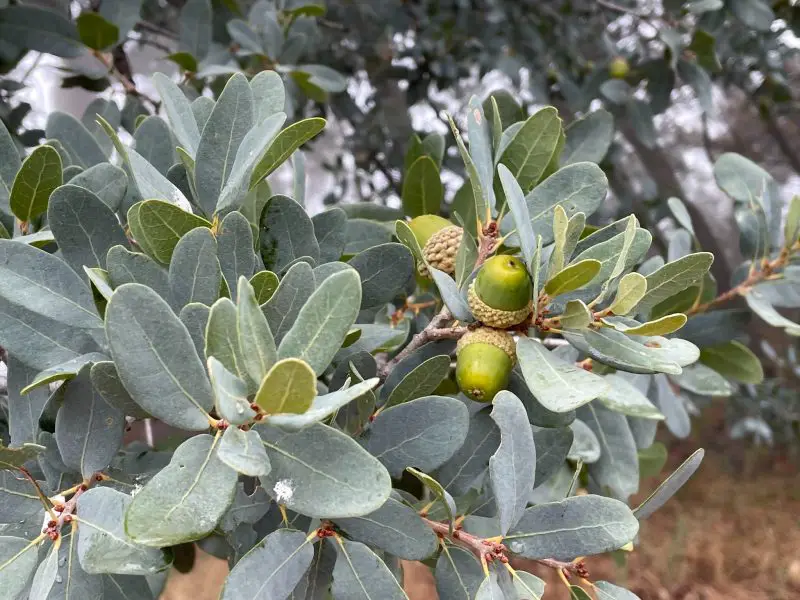
Engelmann Oak is a medium-sized deciduous oak native to southern California, especially the coastal foothills. Typically growing 30 to 50 feet tall, this oak features a broad, spreading crown with thick, ridged bark that darkens with age. Its leaves are thick and leathery, with deep lobes and a dull green color that often turns golden brown in the fall before shedding. The acorns are relatively large and mature in about six months, providing a nutritious food source for wildlife.
This oak is distinguished by its somewhat rounded leaf lobes and the dense canopy it forms, which creates shaded woodland areas. Engelmann Oak often has a gnarled trunk and twisted branches, giving mature trees a rugged and picturesque appearance. Its leaf texture and shape set it apart from other southern California oaks.
Engelmann Oak thrives in well-drained soils on dry slopes and foothills, often found in chaparral and oak woodland communities. It tolerates drought well and prefers regions with hot summers and mild winters. This species is adapted to Mediterranean climates, requiring some winter moisture but capable of enduring extended dry periods.
The range of Engelmann Oak is limited to southern California, primarily in the foothills of the Santa Ana Mountains, San Gabriel Mountains, and other coastal ranges. Because of its restricted distribution, Engelmann Oak is considered a sensitive species, and conservation efforts aim to protect its remaining habitats from development and invasive species.
Leather Oak (Quercus durata)

Leather Oak is a smaller, shrubby evergreen oak native to California’s chaparral and foothill regions. It generally grows as a dense shrub or small tree, rarely exceeding 10 to 15 feet in height. The bark is thin and grayish, while its leaves are thick, tough, and dark green with a leathery texture, often with rolled or wavy edges. The leaf undersides are covered with dense, pale hairs, giving the foliage a somewhat fuzzy appearance.
This oak is recognizable by its stiff, leathery leaves that are oval to oblong and have a distinctive rough texture. The small acorns are enclosed in a scaly cupule and mature in one season. Leather Oak tends to form dense thickets, providing important cover for wildlife and helping prevent soil erosion in steep terrain.
Leather Oak is well adapted to dry, rocky, and nutrient-poor soils typical of chaparral ecosystems. It is highly drought-tolerant and can survive in exposed, sunny locations with limited water. This oak is also fire-adapted, resprouting vigorously after wildfires to quickly reestablish itself in disturbed habitats.
Within California, Leather Oak is primarily found in the Coast Ranges and parts of the Sierra Nevada foothills. Its dense growth and hardiness make it a key species in chaparral plant communities, where it plays an important role in maintaining ecosystem health and providing habitat for small mammals and birds.
Oregon White Oak (Quercus garryana)

Oregon White Oak is a deciduous oak native to northern California and parts of the Pacific Northwest. This oak typically grows between 40 and 80 feet tall, developing a broad, rounded crown and thick, deeply furrowed bark that is gray to dark brown. Its leaves are lobed with rounded tips, bright green in summer, and turn yellow to reddish-brown in fall. The acorns are small to medium-sized, maturing in one season and serving as a valuable food source for wildlife.
The Oregon White Oak is identifiable by its smooth, rounded leaf lobes that differ from the pointed lobes of many other oaks. Its open crown and relatively smooth bark in younger trees also help in identification. This oak forms open woodlands or mixed forests, often creating habitats with diverse understory plants.
Oregon White Oak prefers deep, well-drained soils and grows best in areas with moderate moisture. It is commonly found in savannas, open woodlands, and along streams or valleys. This species tolerates periodic flooding but is also drought-resistant once established, thriving in climates with wet winters and dry summers.
In California, Oregon White Oak’s range is limited to the northernmost regions, including the northern Coast Ranges and the Shasta Cascade area. It extends northward into Oregon and Washington, forming important ecological communities that support numerous animal species. Conservation efforts focus on protecting this oak’s habitat from development and fragmentation.
Scrub Oak (Quercus berberidifolia)
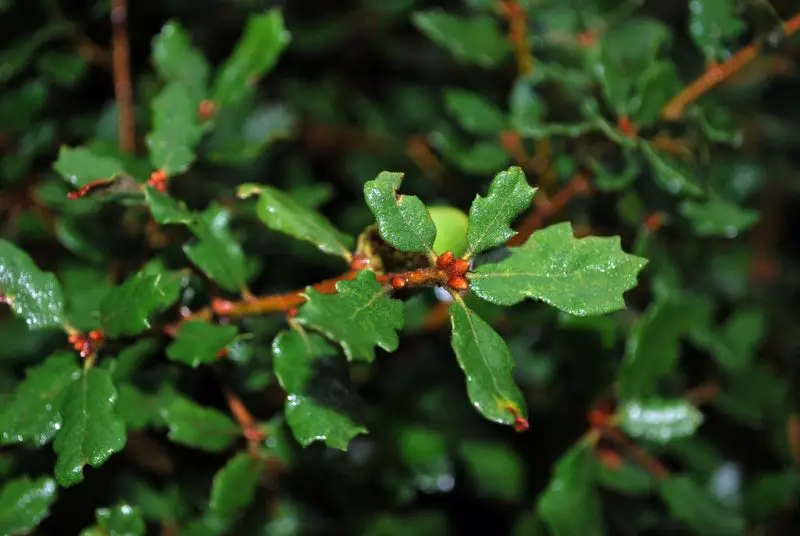
Scrub Oak is a small, shrubby evergreen oak native to California’s chaparral ecosystems. It typically grows as a dense, low shrub ranging from 3 to 10 feet in height, rarely developing a tree form. Its bark is thin and smooth on young stems, becoming thicker and rougher with age. The leaves are small, spiny-toothed, and leathery with a dark green upper surface and lighter, sometimes fuzzy, underside.
This oak is distinguished by its shrubby growth habit and small, sharp-toothed leaves. Scrub Oak often forms dense thickets that dominate the understory in chaparral habitats. Its acorns are small and serve as food for various birds and mammals, though they are less significant than those of larger oak species.
Scrub Oak thrives on poor, rocky soils and is highly drought-tolerant, adapted to the hot, dry summers of California chaparral. It is fire-adapted and often quickly regenerates by resprouting after wildfire, playing a critical role in chaparral recovery and soil stabilization.
This oak is widely distributed throughout California’s Coast Ranges, Transverse Ranges, and southern Sierra Nevada foothills. It is an important species in chaparral ecosystems, supporting biodiversity and helping maintain natural fire cycles. Its dense growth provides shelter for small wildlife and contributes to the characteristic scrubland landscape.
Island Oak (Quercus tomentella)
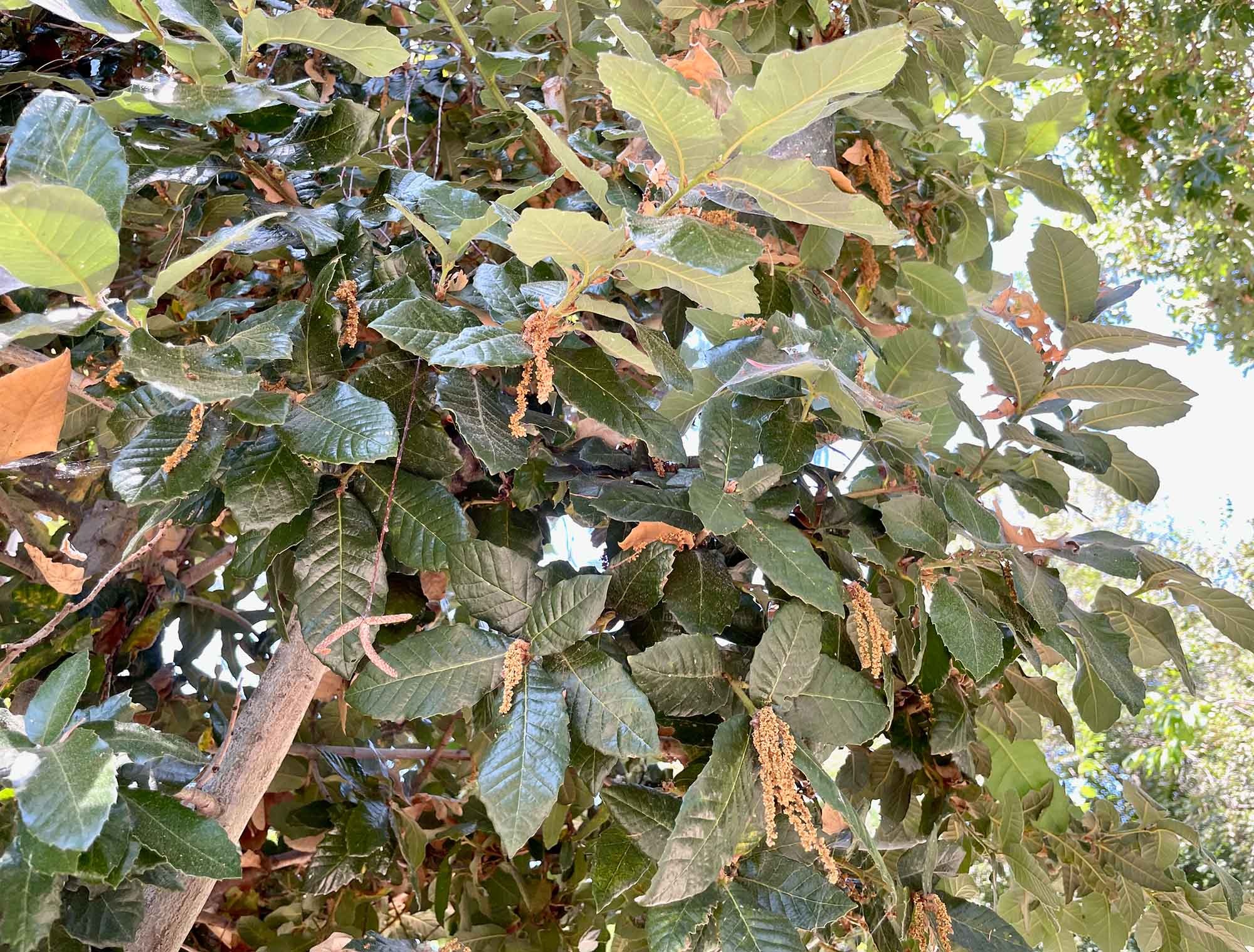
Island Oak is a rare evergreen oak species native exclusively to California’s Channel Islands. It typically grows as a medium-sized tree reaching heights of 30 to 50 feet, although in some cases it may appear as a large shrub. The bark is grayish-brown and furrowed, while its leaves are thick, elliptical, and covered with dense, woolly hairs on the underside, giving them a fuzzy texture. The upper leaf surface is dark green and smooth, contrasting with the soft, hairy underside.
This oak’s distinctive fuzzy leaves and relatively compact size make it easy to identify compared to mainland oaks. The acorns are small to medium in size, maturing in one season, and are encased in a scaly cupule with a hairy rim. Island Oak often grows in groves, providing crucial habitat for native island wildlife and helping to stabilize the fragile island soils.
Island Oak thrives in well-drained, rocky soils and is adapted to the Mediterranean climate of the Channel Islands, with mild, wet winters and dry summers. It often grows in coastal scrub and oak woodland habitats at elevations up to around 2,000 feet. This species is drought-tolerant but also sensitive to environmental disturbances due to its limited range.
The natural range of Island Oak is limited to the four northern Channel Islands off the coast of Southern California, including Santa Cruz, Santa Rosa, San Miguel, and Anacapa Islands. Its isolated distribution makes it a species of conservation concern, with efforts focused on protecting its habitat from invasive species and human impact.
Shreve Oak (Quercus parvula var. shrevei)
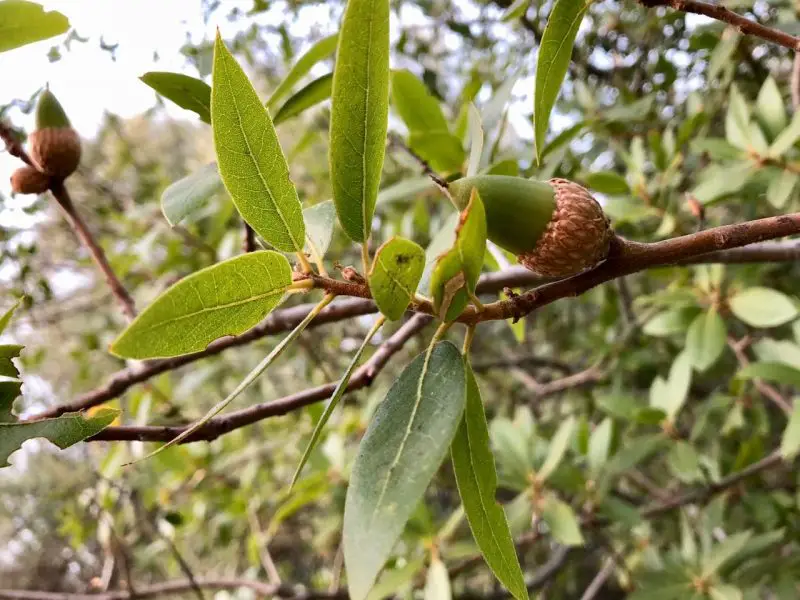
Shreve Oak is a variety of live oak native to the northern parts of California and southern Oregon, primarily found in cooler, coastal mountainous regions. It is a medium-sized evergreen tree growing between 20 and 50 feet tall, characterized by its dense, rounded canopy. The bark is thick, grayish-brown, and furrowed, while its leaves are thick, oval-shaped, and have a leathery texture with smooth margins. The leaf undersides are covered with fine hairs, giving a silvery or grayish appearance.
This oak can be identified by its dense foliage and the slight silvery sheen of the leaf undersides. Its acorns are small and mature in a single season, serving as a food source for various animals. Shreve Oak often forms dense stands in mixed evergreen forests, providing shelter and stabilizing soils on steep slopes.
Shreve Oak prefers well-drained soils and is commonly found in coastal chaparral, mixed evergreen forests, and foothill woodlands. It thrives in areas with cool, moist winters and dry summers, displaying considerable drought tolerance. This variety is adapted to frequent fog and coastal marine influences, which help mitigate summer dryness.
In California, Shreve Oak is limited to northern coastal counties and extends into southern Oregon. It occupies higher elevation areas of the Coast Ranges, where it often grows alongside species like tanoak, madrone, and Douglas fir. Because of its restricted distribution, Shreve Oak is an important species for local biodiversity and ecosystem resilience in coastal forests.
How to Grow and Care for Oak Trees in California
Growing and caring for oak trees in California requires attention to their specific environmental needs and natural adaptations. Oaks generally prefer well-drained soils and plenty of sunlight, making them well-suited to California’s Mediterranean climate with wet winters and dry summers. When planting an oak tree, choose a location with enough space for its mature size, as oaks can develop broad, spreading canopies that need room to grow without competition. It is important to plant young oaks during the cooler months of fall or early spring to give them the best chance to establish strong roots before the heat of summer.
Watering young oak trees regularly during their first few years is essential, especially during prolonged dry spells, but overwatering should be avoided since oaks are drought-tolerant once established. Mulching around the base helps retain moisture, regulate soil temperature, and reduce weeds. Pruning should be done carefully to remove dead or damaged branches and to maintain a healthy structure, ideally during the dormant season to minimize stress on the tree.
Oaks in California are generally resilient to pests and diseases, but monitoring for signs of common issues like oak wilt or sudden oak death is important to protect their health. Providing natural leaf litter around the tree can improve soil fertility and mimic the tree’s native forest environment. By understanding these care practices and respecting the oak’s natural growth habits, gardeners and landowners can successfully cultivate strong, healthy oak trees that thrive in California’s diverse landscapes.

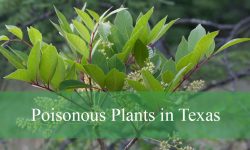
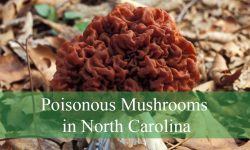




No or4acle oak, eh?
Can this booklet be purchased?